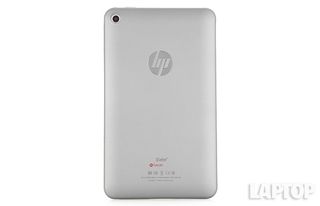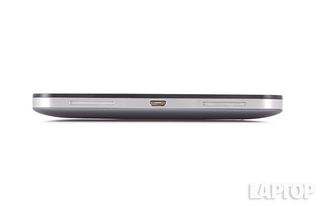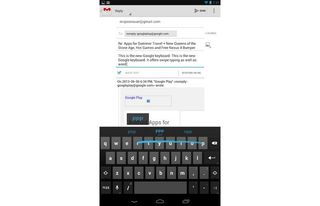Laptop Mag Verdict
The HP Slate 7 sports a premium design and offers Beats Audio for an affordable $169, but its screen and performance trail those of even cheaper tablets.
Pros
- +
Solid build quality
- +
Beats Audio built-in
- +
microSD Card slot
- +
Long battery life
Cons
- -
Low-resolution display
- -
Runs older Android 4.1
- -
Not as fast as competing tablets
- -
Lackluster cameras
Why you can trust Laptop Mag
With its stainless-steel frame and sleek, soft touch back, you might not guess that the HP Slate 7 costs a mere $169. That's a pretty low price for an Android tablet, considering that HP also includes Beats Audio technology and a microSD Card, something you won't find on the pricier Google Nexus 7 or Kindle Fire HD. However, HP has other competition in the sub-$200 price range. Should you snatch up the Slate 7 or pass?
Design

Click to EnlargeWhereas some low-cost tablets have the build quality of a greeting card, the HP Slate 7 feels solid. The front of the device sports chemically treated glass (for extra rigidity), and the stainless-steel frame means this tablet won't creak when you pick it up or twist it. The back of the Slate 7 uses a soft-touch paint that provides a sure grip while lending the gadget a premium vibe.
Our model came in silver, but you can opt for a red version for $30 more. That configuration also has 16GB of memory, compared with 8GB for the entry-level Slate 7.
The top of the Slate 7 houses the headphone jack, microSD Card slot (which is not covered) and a power button that's easy to press. You'll also find two small screws that flank all of these items; they don't mar the aesthetic, but are a bit distracting.

Click to EnlargeA volume rocker lines the right side of the Slate 7, while two speakers flank a microUSB port on the bottom of the device. The back houses a polished chrome HP logo and the lens of the 3-MP camera tucked into the top-left corner.
MORE: Top iPad Alternatives
Measuring 7.8 x 4.6 x 0.42 inches, the Slate 7 has similar dimensions to its 7-inch competition but is slightly narrower, making it easier to hold with one hand. For example, the Hisense Sero 7 Pro measures 5 inches across, and the Nexus 7 and MeMO Pad are 4.7 inches across. However, at 13.1 ounces, the Slate 7 is heavier than other 7-inch tablets. The Nexus 7 and ASUS MeMO Pad weigh 12 ounces, while the Sero 7 Pro weighs 12.7 ounces. Only the Kindle Fire HD (13.9 ounces) is heavier among this group.
Display

Click to EnlargeWhen you go below $199, you shouldn't obsess over specs, but display resolution is important. At 1024 x 600 pixels, the Slate 7's screen doesn't look very sharp compared to the Sero 7 Pro's 1280 x 800-pixel panel. Text looked fuzzier on app shortcuts and on websites. It almost seems as though there's a thin film between you and the content.
On the plus side, the Slate 7's display is fairly bright, measuring 313 lux on our light meter. That's on a par with the Google Nexus 7 (314 lux) and better than the ASUS MeMO Pad (293 lux) but behind the Sero 7 Pro (369 lux) and Kindle Fire HD 7 (436 lux).
When we watched the HD trailer for "The Internship," we could easily make out the wrinkles in Owen Wilson's shirt (and his neck), and we enjoyed fairly wide viewing angles. However, the same clip looked crisper on the Sero 7 Pro.
Reading the Slate 7's display outdoors on a partly sunny day proved challenging. We noticed plenty of glare, and there were visible grid lines.
Audio
Click to EnlargeThe HP Slate 7 includes Beats Audio, which provides a sonic boost to music and movies when you listen to audio with headphones. In the Settings menu, you'll find a control panel that lets you toggle between three different modes: On-Ear, In-Ear and Passive. Since we had a set of on-ear, noise-canceling headphones, we tried the first setting.
When we listened to Coldplay's "Paradise," activating Beats Audio did enhance the low end and made the track sound richer overall, but the bass competed with the vocals more than we would have liked. We appreciated the bigger thump a lot more when we played Busta Rhymes' "Why Stop Now." Beats Audio also improved the sound on games, such as the driving soundtrack to "Riptide GP."
The dual speakers on the bottom of the Slate 7 are serviceable but don't wow. The same tracks sounded louder coming from the Sero 7.
Interface

Click to EnlargeThe HP Slate 7 runs a stock version of Android 4.1.1 Jelly Bean, but it's not the latest version of Google's OS (4.2). That means you can't take advantage of such newer features as a Quick Settings menu, support for lock-screen widgets or multiple user accounts. The Hisense Sero 7 Pro has all of the above.
Click to EnlargeThe good news is that you can access Google Now, which learns from your searches and presents timely info, such as your next flight or how long it will take you to get home based on traffic. You can also see the latest weather, your next appointment and sports scores at a glance. Just swipe up from the Home button at any time to get to Google Now.
Click to EnlargeFrom the lock screen on the Slate 7, you can unlock directly to Google Now, the camera or the home screen with a swipe. There, you'll find a row of six app shortcuts on the bottom, with the Apps button in the middle. There's a trio of buttons underneath that -- Back, Home and Recent Apps -- for multitasking. A Google search bar sits up top this and the other four home screens you can customize.
MORE: 12 Worst Android Annoyances and How to Fix Them
Swiping down from the top reveals the stock notification drawer, complete with a Settings shortcut and screen-rotation button. This is pure Google, with no skin in sight.
Keyboard

Click to EnlargeGoogle recently made its own new Google Keyboard available in the Google Play store, so we downloaded it immediately for the HP Slate 7 to replace its stock layout. A new Gesture Typing feature takes a page from Swype, letting you trace a line between letters to speed up typing. Unlike with Swype, though, you'll see a floating preview of the word as you gesture, so you'll know if you're on the right track.
MORE: 5 Best Keyboard Apps for Android
As with SwiftKey, you also get next-word predictions. For example, when typing "I plan," the Google keyboard guessed we wanted to type "on" next. Voice typing is also on board. Overall, we typed quickly, with few errors, using this layout, but we wish HP offered haptic feedback; key-press options are limited to a sound.
Apps
Click to EnlargeHP doesn't bring anything to the software table on the Slate 7 other than its ePrint app. With this utility, you can print photos, websites and files (Office documents, PDFs) on compatible HP printers. You don't even need to be on the same network as your printer for the app to work, because ePrint works over the Web. If you need a physical copy of something when you're not at home or in the office, you can send that job to one of thousands of HP Public Print locations, such as FedEx Kinkos.
Otherwise, the Slate 7 comes with all of Google's own apps, including Gmail, YouTube, Google +, Hangouts, Maps, Movie Studio, Play Music, Books, Magazines and Music. And with full access to the Google Play store, you can take your pick from over 700,000 apps. The store also has a Tablet Spotlight section, where you'll see such titles as Subway Surfers (game), QuickOffice Pro HD and Hulu Plus.
MORE: 10 Best Android Apps You're Not Using
Performance
Armed with a 1.6-GHz dual-core A9 ARM Cortex processor and 1GB of RAM, the HP Slate 7 offers fairly good performance, but it isn't the fastest tablet in its price range.
Click to EnlargeSwiping between home screens felt smooth on the Slate 7, and apps opened quickly, but we did notice lag when trying to switch between apps in the Recent Apps menu. Sometimes, apps looked oddly squished within their thumbnails, too, which could be a software bug. The Sero 7 Pro (1.3-GHz quad-core Nvidia Tegra 3) multitasked a bit faster, and was also quicker to switch screen orientations in the Chrome browser, though both tablets were neck and neck when loading Web pages.
The Slate 7 easily handled a few demanding games we threw its way. We quickly cruised around the track in the "Riptide GP" Jet Ski racing game, and we happily mowed down flesh-eating aliens in "Dead Trigger." Just don't expect cutting-edge visuals, due to the low-resolution display on the Slate 7. Nor will you be able to enjoy little bits of eye candy enabled by Nvidia's Tegra 3 CPU on the $149 Sero 7, such as water-splashing effects dripping down your screen.
Click to EnlargeTo further gauge the Slate 7's performance, we ran a few synthetic benchmarks. On AnTuTu -- which measures CPU, GPU, RAM and I/O performance -- the HP tablet notched 11,547. That score blows away the single-core-saddled ASUS MeMO Pad's 3,992 (1.5-GHz VIA WM8950 CPU) but is lower than the Sero 7's 12,092.
We also ran Geekbench 2, which measures processor and memory performance. With a score of 937, the Slate 7 again finished between the cheaper MeMO Pad (559) and the Sero 7 Pro (1,283). Lastly, the Slate 7 registered 2,198 on 3DMark Extreme, which measure graphics prowess. The ASUS couldn't run the test, but the Sero 7 Pro scored a 1,942.
Cameras
[sc:video id="BjNnE1cTp_A97urGsdSfRg0X8qZ4rm02" width="575" height="398"]

Click to EnlargeHP Slate 7's camera is better than nothing, but just barely. The HP Slate 7 comes with a back 3-MP camera that you can use for taking a quick picture to post to Facebook. However, chances are, your smartphone takes much better pics. An image we captured of a vending machine had fairly vibrant color but came out fuzzy. The VGA videos this camera recorded looked worse; footage we shot of our office looked terribly blocky.
The front VGA camera didn't fare much better. A shot we took of our face appeared blotchy. You can video chat with this tablet, but we wouldn't necessarily recommend it.
Battery Life
One bright spot is the Slate 7's endurance. On the LAPTOP Battery Test (Web surfing via Wi-Fi), the tablet lasted 7 hours and 34 minutes. That's about half an hour longer than average, nearly 90 minutes longer than the Hisense Sero 7 Pro (6:09), and on a par with the Kindle Fire HD 7 (7:30) and the Google Nexus 7 (7:26).
MORE: 10 Tablets with the Longest Battery Life
Verdict

Click to EnlargeWe like some aspects of the HP Slate 7, but we'd like the tablet a lot more if it cost less. On the plus side, this $169 device has a premium design, long battery life, a microSD Card expansion and Beats Audio. The Slate 7 also performs fairly well with its dual-core processor. However, the low 1024 x 600-pixel screen resolution pales in comparison to the 1280 x 800 display on the $149 Hisense Sero 7 Pro, which also boasts a speedier quad-core CPU.
The Slate 7 is also priced too closely to the $199 Nexus 7 and Kindle Fire HD, which offer sharper displays and better performance. Another option is the $99 Hisense Sero 7 LT -- which has half as much storage as the HP (4GB vs. 8GB), but otherwise similar specs -- for $70 less. Overall, the Slate 7 is worth a look, but it's not the best bargain tablet.
HP Slate 7 Specs
| Brand | HP |
| CPU | 1.6-GHz dual-core A9 ARM Cortex |
| Camera Resolution | 3MP |
| Card Reader Size | 32GB |
| Card Readers | microSD |
| Company Website | http://www.hp.com |
| Display Resolution | 1024x600 |
| Display Size | 7 |
| Front-Facing Camera Resolution | VGA |
| Has Bluetooth | Yes |
| OS | Android 4.1 |
| Ports | Headphone, microUSB |
| RAM Included | 1GB |
| Size | 7.8 x 4.6 x 0.42 inches |
| Storage Drive Size | 8GB |
| Storage Drive Type | Flash Memory |
| Warranty / Support | 1-year limited hardware warranty with 90 days of free software support |
| Weight | 13.1 ounces |
| Wi-Fi | 802.11b/g/n |
